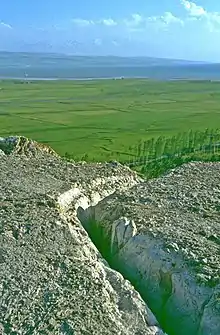| Menua | |
|---|---|
| King of Urartu | |
| Reign | c. 810–c. 786 BC |
| Predecessor | Ishpuini |
| Successor | Argishti I |
| Born | ca. 850 BC |
| Died | ca. 786 BC |
| Issue | Inushpua, Tariria, Argishti I |
| Father | Ishpuini |
Menua (Urartian: mMe-i-nu-a [variations exist]),[1] also rendered Meinua or Minua, was the fifth known king of Urartu from c. 810 BC to approximately 786 BC. In Armenian, Menua is rendered as Menua. The name Menua may be connected etymologically to the Ancient Greek names Minos and Minyas.[2][3]
A younger son of the preceding Urartian King, Ishpuini, Menua was adopted as co-ruler by his father in the last years of his reign. Menua enlarged the kingdom through numerous wars against the neighbouring countries and left many inscriptions across the region, by far the most of any Urartian ruler.[4] He organized a centralised administrative structure, fortified a number of towns and constructed fortresses. Amongst these was Menuakhinili located near Mount Ararat (its exact location is uncertain, perhaps at Bulakbaşı, east of modern-day Iğdır).[5] Menua developed a canal and irrigation system that stretched across the kingdom. The most significant of these was a 45 mile canal from the Hoşap valley to Van, which was named the Menua Canal after the king.[6] It flowed at a rate of 1500 to 3000 litres of water per second, depending on the time of the year.[7] Several of these canals are still in use today.
He briefly co-ruled with his son, Inushpua, but was succeeded by another son, Argishti I.[8] Menua also had a daughter named Tariria, after whom a certain vineyard was named Taririakhinli.[9]

It is believed that Menua founded the city of Manazkert (Malazgirt).[10]

See also
References
- ↑ Zimansky, Paul (2011). "Urartian and the Urartians". In Steadman, Sharon R.; McMahon, Gregory (eds.). The Oxford Handbook of Ancient Anatolia. Oxford University Press. p. 554. ISBN 9780195376142.
- ↑ Petrosyan, Armen (2002). The Indo-European and Ancient Near Eastern Sources of the Armenian Epic. Washington D.C. 2002. Washington, D.C.: Institute for the Study of Man. p. 182.
- ↑ Petrosyan, Armen (April 2019), "On the Ethnic Origin of the Ruling Elite of Urartu", Over the Mountains and Far Away: Studies in Near Eastern History and Archaeology presented to Mirjo Salvini on the occasion of his 80th birthday, Archaeopress, p. 405.
- ↑ Zimansky, Paul (1985). Ecology and Empire: The Structure of the Urartian State (PDF). Oriental Institute of the University of Chicago. p. 59. ISBN 0-918986-41-9. OCLC 469553313.
- ↑ Zimansky 1985, p. 64.
- ↑ Sagona, Antonio; Zimansky, Paul (2009). Ancient Turkey. London: Routledge. p. 323. ISBN 978-0415481236.
- ↑ Chahin, M. (1987). The Kingdom of Armenia. London: Croom Helm. pp. 67. ISBN 070994800X.
- ↑ Chahin, M. (2001). The Kingdom of Armenia: A History. p. 23. ISBN 9780700714520.
- ↑ Zimansky 1985, p. 69.
- ↑ Neusner, J. (1966). A History of the Jews in Babylon, Volume 1. p. 77.